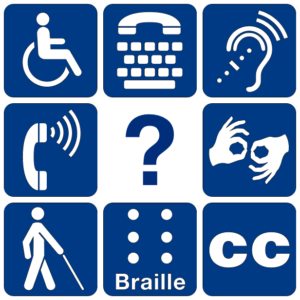
Accessibility has recently become a crucial talking point in digital humanities. Some scholars have argued that the best way to account for accessibility is to implement universal design principles when developing DH projects. This post considers positive and negative aspects of universal design in DH and advocates for a more practical modified solution.
Accessibility, or “how a disabled person accesses or benefits from a site, system[,] or application,” has become a topic of great importance in the digital humanities (DH) community, as evidenced by its appearance as the main theme of the international DH2017 conference. Similarly, best practices papers have described implementation of accessibility standards as a requirement for DH projects. With this new emphasis, digital humanists have been suggesting solutions to make DH projects more accessible.
Universal Design in DH
One DHer, George Williams, advocates for universal design as an accessibility solution. Ron Mace, founder and program director of North Carolina State University’s Center for Universal Design, coined the term “universal design” in the late 1990s. Mace envisioned design that could be used by anyone on any platform, accounting for the needs of those with visual, hearing, or motor impairments while maintaining an attractive and functional website for non-disabled people.
More recently, the Center for Inclusive Design and Environmental Access has implemented eight goals of universal design, including:
-
Body fit
- Comfort
- Awareness
- Understanding
- Wellness
- Social integration
- Personalization
- Cultural appropriateness
With these goals in mind, Williams argues that DHers can make design decisions that allow both disabled and non-disabled people to use their final product.
Benefits of Universal Design
Williams’ article highlights several positive aspects to universal design in the context of digital humanities. For one, it accounts for different ways disabled people use technology and includes not only the computer screen, but also tactile surfaces and auditory screen readers. By making a website compatible with several types of devices, designers open it up to a greater number of users.
Williams also points out that universal design is compliant with accessibility standards being applied to DH projects, especially in international contexts. Many countries around the world, including Canada, India, and Japan, require proof of accessibility to be federally funded. Although it is not a legal requirement in the United States, several organizations demand project websites comply with accessibility standards, making universal design methods more appealing.
Drawbacks of Universal Design
Despite many positive aspects, however, Jonathan Hsy, a non-disabled scholar, and Rick Godden, a disabled scholar, indicate two major difficulties that hinder universal design. The first is that universal design “is a myth.” Hsy calls it the “Holy Grail” of design: tantalizing, but ultimately unobtainable because it is impossible to account for all media, languages, and impairments. For instance, he describes the Deaf Studies Digital Journal, which uses American Sign Language for its content, making it inaccessible to the hearing majority. Although this is a case of accessible design, it is not universal design.
Even the language that Williams uses when advocating for universal design in DH hints at its impossibility. He argues that DH projects be compatible “with desktop computers, laptops, smart phones, and tablets… refreshable Braille displays, digital talking book devices, screen reader applications, and screen magnification software.” It is not realistic to expect DH project managers to know about and accommodate all of these types of devices. Moreover, by requiring this versatility, DH becomes inaccessible to the underfunded.

The second major difficulty is that universal design does not address all types of impairments and the embodied experiences of disabled people. Godden argues that even well intentioned universalist views can “[efface] crucial particularities of embodied experience.” For example, when Williams describes the benefits of universal design he only remarks on people who are deaf or hard of hearing, those who are blind or have low vision, and people who have trouble distinguishing certain colors. This is a very limited view on disabilities that disregards the individual’s needs; disabled people risk becoming homogenized and therefore neglected.
Conclusion
Universal design is an optimistic solution for accessibility in digital humanities, but may not be a practical one. Although it would be ideal to implement design features that serve all users, Godden suggests that DHers focus on balancing the principles of universal design with “the particulars of embodied experience.” Perhaps the lesson is to accommodate the maximum number of users possible by implementing simple and inexpensive fixes such as the usage of alt-text, which could be easily accomplished even in a small DH project. Furthermore, usability testing with actual disabled users would be the best course of action. Designers of DH websites could find out what needs are not being met and implement helpful and affordable solutions to accommodate people who are actually using their site.
References
- Alliance for Digital Humanities Organizations. (2017). DH 2017 Montréal. Retrieved from https://dh2017.adho.org/
- Godden, R. & Hsy J. (2016, January 6). Universal design and its discontents. Retrieved from http://www.disruptingdh.com/universal-design-and-its-discontents/
- IDeA Center. (2012). What is UD?. Retrieved from http://www.universaldesign.com/what-is-ud/
- North Carolina State University Center for Universal Design. (2008). About the center: Ronald L. Mace. Retrieved from https://projects.ncsu.edu/ncsu/design/cud/about_us/usronmace.htm
- University of Nebraska-Lincoln Center for Digital Research in the Humanities. (2017). Best practices for digital humanities projects. Retrieved from http://cdrh.unl.edu/articles/best_practices
- US Department of Health & Human Services. (2017). Accessibility basics. Retrieved from https://www.usability.gov/what-and-why/accessibility.html
- Williams, G. H. (2012). Disability, universal design, and the digital humanities. In Debates in the digital humanities. Retrieved from http://dhdebates.gc.cuny.edu/debates/text/44
